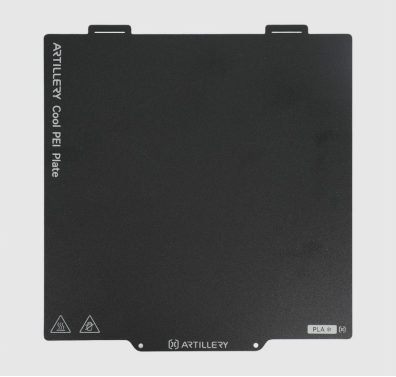¶ Textured PEI Plate
Textured PEI Plate is made by coating a stainless steel sheet with a layer of PEI powder, creating a textured surface on both sides. What sets it apart is its special rough texture, which is transferred to the bottom surface of your prints. This plate works well with a variety of materials and often provides excellent adhesion without the need for adhesives, making it user-friendly. Additionally, the PEI coating on the plates is durable and has a long lifespan.
The included blade in the package can be used to remove prints from the build plate. Please use with caution.
.jpg)
¶ Cool Plate SuperTack
The low-temperature stabilization print bed is made by spraying SuperTack on a spring steel plate, suitable for PLA and PETG filaments.
It can firmly hold the model at a low heated bed temperature of 50°C when printing PLA, effectively reducing warping and issues like "face lifting," especially when printing large models, significantly lowering the risk of warping. The stabilization coating is highly durable, with adhesion strength dropping by less than 20% after 300 prints, greatly extending the print bed's lifespan. Additionally, the coating significantly reduces the energy required for heating the bed, lowering electricity costs and making it more environmentally friendly.
Note: This plate is not suitable for printing with TPU filament, as it may damage the coating.

¶ Textured Low-Temperature PEI Print Plate
The stainless steel plate features a dual-sided coating,one side with Textured PEI, and the other with Low-Temperature PEI. Users can choose different surface textures according to their needs, resulting in a matte or smooth texture on the model's bottom surface, providing more printing options.
.jpg)
¶ 3D Effect Sheet
Using laser technology, fine optical textures are formed on the surface of the film, imparting optical properties such as increased transmittance, reflection, and polarization. During the printing process, the high-temperature polymer flows into these textures, transferring them to the bottom surface of the printed model. Depending on the angle of the light, the model's bottom surface displays different color effects. Currently, four patterns are available for selection: diamond, starry, galaxy, and carbon fiber.
.jpg)
¶ Wipe zone on the build plate
Before printing, there may be some filament residue remaining on the nozzle, and if not cleaned, it can cause surface defects on the printed object. Therefore, the nozzle is first wiped on a nozzle wiper before printing starts and then repeatedly wiped in a specific area on the build plate (wipe zone). This helps to clean the filament residue on the nozzle and stabilize the chamber pressure inside the nozzle. This prevents surface defects on the printed object due to filament residue on the nozzle.
For the M1 printer, as the nozzle comes into direct contact with the build plate, there may be some "wear" observed in the wiping zone (as shown in the image below). However, this phenomenon does not affect the functionality of the nozzle or the build plate.
.jpg)